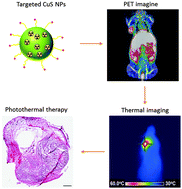Copper sulfide nanoparticles (CuS NPs) have been reported as a single-compartment theranostic nanosystem to visualize and treat tumors simultaneously. However, few studies have investigated the in vivo tumor-targeted delivery of this class of nanoparticles. In this study, we introduced a tumor-specific targeting ligand, folic acid (FA), onto the surface of CuS NPs as a model system to demonstrate the feasibility of actively targeted CuS NPs for positron emission tomography (PET) imaging and PET image-guided photothermal therapy (PTT). A one-pot synthetic method was used for introducing FA to CuS NPs to yield FA–CuS NPs. Biodistribution studies in mice bearing folate receptor-expressing KB tumor showed a significantly higher tumor uptake of FA–CuS NPs than non-targeted polyethylene glycol (PEG)-coated PEG–CuS NPs after intravenous injection. Moreover, tumor uptake of FA–CuS NPs could be effectively blocked by free FA. Biodistribution and clearance of 64Cu-labeled FA–CuS NPs (FA–[64Cu]CuS NPs) could be readily visualized by microPET (μPET), which confirmed a significantly higher level of tumor uptake of FA–[64Cu]CuS NPs than non-targeted PEG–[64Cu]CuS NPs. μPET image-guided PTT with FA–CuS NPs mediated a substantially greater tumor damage compared with PTT mediated by PEG–CuS NPs. Thus, FA–CuS NPs are promising candidates for PTT of folate receptor-positive tumors.
